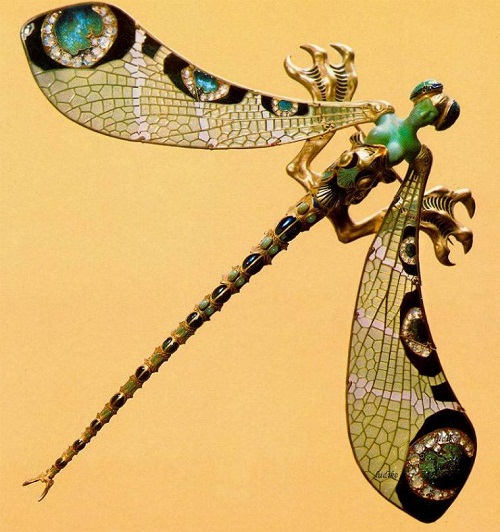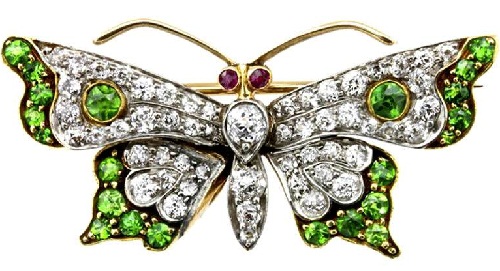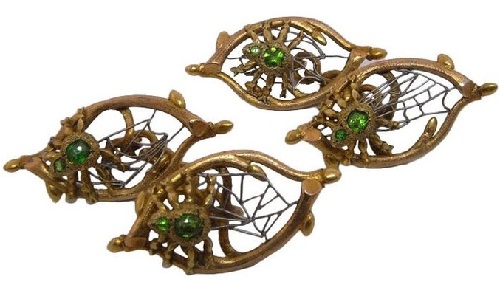Insect Jewellery Kaleidoscope

Beetle crawling the flower Entomological Brooch. Gold, diamonds, pearls, opal. 1879. Insect Jewellery Kaleidoscope
Insect Jewellery Kaleidoscope
Love for insect designs existed at all times, but the real passion for them began in the early XIX century, due to the development of the natural sciences. Since then, bugs, butterflies, ants, ladybirds, dragonflies and spiders forever became one of the most popular images in jewelry. Indeed, nearly all fashion houses have their precious insectarium, replenished from time to time with new swatches.
Jewelers of XIX century not just used images of insects, but almost copied naturalistic albums with sketches and ordered sketches from entomologists. Actually, the correct word for insect jewelry of XIX century would be “entomological”.
Insect Jewellery Kaleidoscope, symbolism
A dragonfly as if confirms a proactive stance of a man who chooses such jewelry. In addition, like a butterfly, it is a symbol of salvation of the soul and a short but beautiful human life, lightness, grace and levity.
Scarab beetle to the ancient Egyptians – god Khepera, a symbol of immortality, eternal life, a new sun born every morning, and at the same time the way that it makes. Scarab – a symbol and a synonym for the soul, and persistent movement towards the goal and the path to the wisdom of the pupil.
Insect Jewellery Kaleidoscope symbolism
The image of a ladybug should be also mentioned. It received its name from the fact that many people considered it an insect of Virgin. In all cultures ladybug stands as a symbol of good luck and good news, as well as a symbol of grace, kindness and forgiveness. It is believed that the ladybug acts as a messenger between humans and God. To find ladybug was considered a good omen.
Ladybird was associated with the Great Goddess, and later was an attribute of the Virgin. Hence its name in European languages: “Our Lady Bird,” “beetle of Mary.” In Norway it is called very funny “chicken of Mary.” Nowadays ladybird became to symbolize love and sexuality.
In addition, specific spots on the back, made using precious stones, very harmoniously fit into the image of any product. And the sheer number of spots on the shell also has a certain symbolic significance: the more spots, the more this is considered good luck charm. One spot – a great start to the new deal, the two – a symbol of harmony, three – people will be able to find the right solution in a difficult situation, four spots – protection against theft, five – enhance creativity, six – will help in the study, seven – a special sign a pledge of good luck in all cases.
Slightly less were used images of wasps and flies. Bee is not only a symbol of hard work, but also creation, but the wasp – a more complex character that later became associated with a sharp tongue and ability to fend off the attacks of enemies.
Bee and bumblebee have always been associated with hard work, the wasp – with perseverance and a fly with business activity.
Insect Jewellery Kaleidoscope
Perhaps there is no more controversial image, and at the same time, more fashionable at all times, than the image of a spider. It is the creator of the world, and the treacherous and cunning hunter. Our ancestors saw a spider sitting in the center of its web, the solar deity, to create itself from the universe. With spider related topic and weaving in all senses.
Fly – not only the victim but also the protector. Images of flies on ancient gems were a talisman against evil. It is also a symbol of courage – brave soldiers in ancient times were awarded gold flies. Fly was portrayed quite often in life-size in the most prominent place in the paintings of Dutch, German and Italian artists of XV-XVI centuries. It is a talisman against real insects that could defile the picture.
Cicada – a symbol of longevity, happiness and eternal youth. Likely explanation for this is the fact that the cicada lives longer than any other insects – to 18 years. The origin of this symbol appears to be associated with the legend of the cicadas: she was kind and fair queen, reborn after death in the form of cicada. Becoming a cicada, it did not grow old physically and lived longer than all other insects. Since then, the cicada became a symbol of eternal youth.
Insect Jewellery Kaleidoscope
Superiority in the manufacture of jewelry insect belongs to Louis-Francois Cartier, “the king of jewelers and the jeweler of kings”. By the twentieth century, the popularity of insects has increased thanks to the famous Rene Lalique, a passionate lover of insects. The dragonfly is considered one of the most popular images in his jewelry, although he did not pass by other “winged” creatures:
For the Paris World Exhibition in 1900, Alphonse Mucha and Georges Fouquet developed a collection of art nouveau. These ornaments are very different from the traditional jewelry designs at the time, but the audience and critics took them favorably. In that collection – a lot of insects too:
One of the most recognized contemporary insect amateur jewelers is considered Gilbert Albert, who always said that the beauty of jewels lies not in the number of carats, but in the original idea of performance. However, most jewelry collections of jewelry house Gilbert Albert framed in precious metals and precious stones are the same.
Traditionally, such famous Russian jewelers as Ovchinnikov, Sazikov, Khlebnikov, and Faberge made insect design jewelry. They used the new-fangled technologies of enamel, filigree guilloche, as well as a whole bunch of inlaid precious stones: amethyst, garnet, agate, and many others.
Insect Jewellery Kaleidoscope

Swiss watch-brooch in the form of a beetle. Gold, enamel guilloche, diamonds. By pressing the button on the tail, wings open, showing the dial. The end of the 19th century









































